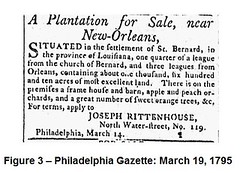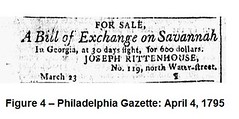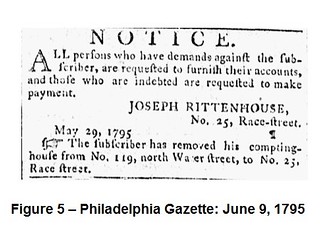
PREV ARTICLE
NEXT ARTICLE
FULL ISSUE
PREV FULL ISSUE
FINKELSTEIN ON DR. DAVID RITTENHOUSE – PART 1
David Finkelstein submitted this article about the first U.S. Mint Director, David Rittenhouse. Thanks! Look for more in subsequent
issues. -Editor
By David Finkelstein Introduction
Falsity #1 – David Rittenhouse Was Incarcerated In Debtors’ Prison
By 1798, Robert Morris was bankrupt and in financial ruin. Beginning in February, 1798, he served 3 ½ years in Philadelphia’s debtors’ prison. In a letter he wrote from debtors’ prison on September 29, 1798 regarding the Yellow Fever Epidemic, he stated: Our prisoners are gone, except the sick, Banks, Rittenhouse, and myself. Poor Dick is very ill, and they begin to say he is to die… They all have the fever, but still I am not alarmed, although in the house with it. I keep up stairs and avoid all intercourse as much as I can. I have written to William to not to come to-morrow. Within recent years, it became the belief of a few researchers that the Rittenhouse referred to in Robert Morris’s September 1798 letter was Dr. David Rittenhouse, the first Director of the United States Mint. Since Rittenhouse’s death was widely publicized in Philadelphia newspapers two years earlier, it was then theorized that Rittenhouse did not, in fact, die in 1796. His June 26th death, June 27th burial, and December 17th Eulogium to hundreds of family members, friends, business acquaintances, heads of state (including President Washington), members of Congress, foreign dignitaries, and Philadelphia residents was suggested to have been a massive cover up to maintain the integrity of his image and to protect his reputation. This wild theory also identified Dr. Benjamin Rush (a signer of the Declaration of Independence), and William Barton (consultant to the third committee tasked to develop the Great Seal of the United States and the nephew of David Rittenhouse) as the two people who conspired to fake Rittenhouse’s death. David Rittenhouse Was Not Incarcerated In Debtors’ Prison
Monday, December 12, 1796. A petition of Joseph Rittenhouse, of the city of Philadelphia, merchant, now confined in the debtors’ apartment in the said city, was presented to the House and read, praying relief, in the case of a judgment obtained against him in the District Court of Pennsylvania, on behalf of the United States. Per pages 744 and 745 of the same journal: Six o’clock, P.M. Friday, March 3, 1797. Mr. Swanwick, from the committee to whom was referred, on the twelfth of December last, the petition of Joseph Rittenhouse, made a report; which was read, and ordered to lie on the table. Per page 494 of Annals of the Congress of the United States. Fifth Congress, Gales & Seaton, 1851: Tuesday, January 30, 1798. Mr. Ross presented the petition of Joseph Rittenhouse, stating that he is a prisoner at the suit of the United States, and, having surrendered his property, prays to be liberated; and the petition was read. Ordered, That it lie on the table. Per page 157 of Journal of The House of Representatives of the United States, Being the First Session of the Fifth Congress: Begun and Held at the City of Philadelphia, May 15, 1797, Volume III, Reprinted by order of the House of Representatives, Gales & Seaton, 1826: Friday, February 2, 1798. A petition of Joseph Rittenhouse, late a merchant of the City of Philadelphia, now confined in the debtor's apartment, in the said City, was presented to the House and read, praying relief, in the case of a judgment obtained against him, on behalf of the United States, in the District Court of the United States for the District of Pennsylvania. Per the 1791 Philadelphia Directory and 1793 Philadelphia Directory, Nichola Lewis, Esq., was the “keeper of the debtors apartment, Pruan St”. Per the 1794 Philadelphia Directory, Nichola Lewis was corrected to Nicholas Lewis as the “brigadier general at the debtors department, Pruan St”. Prune Street was either misspelled multiple times in the 1791, 1793 and 1794 directories [highly unlikely], it was renamed to Prune Street sometime in 1794 or 1795, or it was also referred to as Prune Street. Per the 1795 Philadelphia Directory, John Dickson was the “Keeper of the Debtors apartment, Prune Street”. In the 1796 Philadelphia Directory, Prune Street reverted back to Pruan Street, and John Dickson was the “keeper of the debtor’s apartment, Pruan Street”. There was no mention of a debtors’ apartment or debtors’ prison in the 1797, 1798 or 1799 directories. [Note: to confuse things even more, references to Pruan and Prune Streets eventually disappeared, reemerging as part of Locust Street. The debtors’ apartment was located at what is now the intersection of Locust and Sixth Streets.] Who Was Joseph Rittenhouse?
Joseph Rittenhouse advertised 10 times in Philadelphia newspapers between March 10, 1795 and April 4, 1795. See Figures 1 through 4. On June 9, 1795 he placed a notice in the Philadelphia Gazette requesting all persons that had demands against him to furnish him their accounts. See Figure 5. He was eventually sentenced to debtors’ prison, located on Pruan Street, later Prune Street, and now Locust Street.  
 

Based on my research from multiple genealogy websites, and Genea-Biographical History Of The Rittenhouse Family And All Its Branches In America, With Sketches Of Their Descendants, Daniel K. Cassel, 1893, I was able to locate three people with the name of Joseph Rittenhouse who lived in the Philadelphia metropolitan area during the latter part of the 18th century. All three were David Rittenhouse’s cousins. David Rittenhouse’s grandfather, the Reverend Nicholas Rettinghouse, was born in 1666 in Mulheim, Germany. He emigrated to New York, then moved to Germantown, PA. He had 14 children. Matthias Rittenhouse was born in 1702. He was the son of Nicholas above. Matthias had 10 children, and was the father of David Rittenhouse, the first Director of the United States Mint. David was born on April 8, 1732 in Germantown, PA (7 miles north of Philadelphia). Henry DeWees Rittenhouse was born in 1700. He was the son of Nicholas, brother of Matthias, and therefore was David’s uncle. He had 7 children. 1. One of Henry DeWees children, William (David’s 1st cousin), was born in 1723 in Roxborough Township, PA. William had 11 children. One of William’s sons, Joseph (David’s 2nd cousin), was born on March 3, 1776 in Germantown, PA. This Joseph Rittenhouse would have been 19 years old when the ads in Figures 1 - 5 were placed in Philadelphia newspapers. 2. Another of Henry DeWees children, Nicholas (David’s 1st cousin), was born in 1725 in Roxborough Township, PA. Nicholas had 4 children. One of his sons, Martin (David’s 2nd cousin) was born on February 12, 1747. Martin was a miller by trade, and owned a mill along the Wissahickon Creek in Roxborough Township, PA. He is most likely the Martin Rittenhouse identified in the Philadelphia Gazette ad in Figure 1. One of Martin’s 8 children, Joseph (David’s 3rd cousin) was born on October 9, 1776. This Joseph Rittenhouse would have been 18 years old when the ads in Figures 1 - 5 were placed in Philadelphia newspapers. 3. A third child of Henry DeWees, Henry (David’s 1st cousin), was born in 1730 in Norritown, PA (just north of Norristown and 20 miles northwest of Philadelphia). Henry had 6 children. One of Henry’s sons, Joseph (David’s 2nd cousin) was born on May 20, 1766 in Worcester Township, PA (25 miles northwest of Philadelphia). This Joseph Rittenhouse was the first cousin of Martin Rittenhouse, and is the best candidate for possibly being the Philadelphia merchant who was incarcerated in debtors prison in 1796, 1797 and 1798. Additional research is required. Conclusion
To be continued… Wayne Homren, Editor The Numismatic Bibliomania Society is a non-profit organization promoting numismatic literature. See our web site at coinbooks.org. To submit items for publication in The E-Sylum, write to the Editor at this address: whomren@gmail.com To subscribe go to: https://my.binhost.com/lists/listinfo/esylum All Rights Reserved. NBS Home Page Contact the NBS webmaster 
|